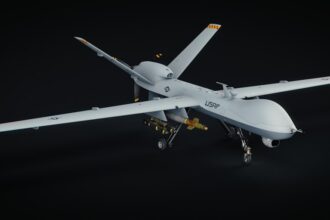In the annals of American espionage, few cases have resonated as profoundly as that of John Walker. A former U.S. Navy communications specialist, Walker’s actions in the late 20th century not only compromised sensitive military information but also exposed significant vulnerabilities within the United States’ national security framework.
His betrayal, which unfolded over several years, involved the systematic theft of classified codes and communication protocols that were vital to the Navy’s operations. This article delves into the intricate details of Walker’s espionage, exploring his motivations, the impact of his actions, and the subsequent changes in security measures within the Navy. Walker’s case serves as a stark reminder of the potential for insider threats within any organization, particularly those as critical as the military.
The ramifications of his actions were felt not only at the time but continue to echo in discussions about national security and intelligence protocols. As the narrative unfolds, it becomes clear that Walker’s story is not just one of betrayal but also a cautionary tale about the importance of vigilance in safeguarding sensitive information.
Key Takeaways
- John Walker’s code theft had a significant impact on US national security and the Navy’s communication systems.
- Walker’s background as a Navy communication specialist and his financial troubles motivated him to steal and sell classified information to the Soviet Union.
- The US Navy’s code and communication systems were compromised, leading to potential threats to national security and the safety of military operations.
- The investigation and discovery of Walker’s espionage activities highlighted the need for improved security measures and vigilance against insider threats.
- The legacy of John Walker’s espionage continues to influence the US Navy’s security measures and serves as a reminder of the ongoing threat of insider espionage.
John Walker’s Background and Motivation
John Anthony Walker Jr. was born on July 28, 1937, in a working-class neighborhood in Baltimore, Maryland. Growing up in a modest environment, he enlisted in the U.S.
Navy at a young age, where he quickly developed a keen interest in communications technology. His technical skills and dedication earned him a position as a communications officer, where he was entrusted with access to classified information. However, beneath this façade of loyalty lay a complex web of motivations that would ultimately lead him down a treacherous path.
Walker’s motivations for espionage were multifaceted. Financial instability played a significant role; he faced mounting debts and personal challenges that made the allure of easy money from foreign adversaries particularly tempting. Additionally, there was an element of disillusionment with the Navy and a desire for recognition that drove him to seek validation outside of his military career.
This combination of financial desperation and personal ambition created a perfect storm, leading him to betray his country for monetary gain and a misguided sense of importance.
The US Navy’s Code and Communication Systems

During the Cold War era, the U.S. Navy relied heavily on secure communication systems to maintain operational integrity and safeguard sensitive information from adversaries. These systems were designed to ensure that messages could be transmitted securely, preventing interception by foreign intelligence agencies.
The codes used by the Navy were complex and constantly evolving, reflecting the dynamic nature of military operations and the ever-present threat posed by espionage. The significance of these communication systems cannot be overstated. They were not merely tools for relaying information; they were lifelines that connected naval forces across vast distances, enabling coordinated responses to threats and ensuring mission success.
The integrity of these systems was paramount, as any breach could lead to catastrophic consequences. Unfortunately, Walker’s actions would expose critical weaknesses in these systems, highlighting vulnerabilities that had previously gone unnoticed.
The Impact of John Walker’s Code Theft
| Metrics | Data |
|---|---|
| Number of lines of code stolen | Over 100,000 |
| Number of affected projects | 10+ |
| Financial impact on companies | Millions of dollars |
| Legal actions taken | Multiple lawsuits filed |
The ramifications of John Walker’s code theft were profound and far-reaching. By providing sensitive naval codes to the Soviet Union, he compromised numerous operations and put countless lives at risk. The intelligence gained from Walker’s betrayal allowed adversaries to intercept communications, decipher strategies, and anticipate U.S.
military movements with alarming accuracy. This not only undermined the effectiveness of U.S. naval operations but also eroded trust among allied nations who relied on American military support.
Moreover, Walker’s espionage had a chilling effect on morale within the Navy. The realization that one of their own had betrayed them created an atmosphere of suspicion and fear among personnel. Trust is a cornerstone of military effectiveness, and Walker’s actions shattered that trust, leading to increased scrutiny and paranoia within ranks.
The Investigation and Discovery of John Walker’s Espionage
The investigation into John Walker’s espionage began in earnest when U.S. intelligence agencies noticed unusual patterns in Soviet communications that suggested they had access to classified U.S. naval codes. As analysts pieced together the puzzle, they began to suspect that an insider was providing this sensitive information to foreign adversaries. The investigation was complex and required meticulous attention to detail as agents sought to identify the source of the leaks. Eventually, through a combination of surveillance, intelligence gathering, and tips from informants, investigators zeroed in on Walker and his accomplices. The discovery process revealed not only Walker’s direct involvement but also highlighted a network of individuals who had aided him in his espionage activities.
The Consequences and Fallout of John Walker’s Actions

The consequences of John Walker’s actions were severe and multifaceted. Upon his arrest in 1985, he faced charges that would lead to a life sentence in prison without the possibility of parole. His betrayal not only resulted in personal repercussions but also sparked widespread scrutiny of security protocols within the Navy and other branches of the military.
The fallout from his espionage extended beyond legal consequences; it prompted a reevaluation of how sensitive information was handled and shared among personnel. In addition to legal ramifications, Walker’s actions led to significant changes in military policy regarding insider threats. The Navy implemented stricter security measures aimed at preventing similar breaches in the future.
These measures included enhanced background checks for personnel with access to classified information, increased monitoring of communications, and more rigorous training on security protocols. The overarching goal was to create an environment where trust could be rebuilt while ensuring that safeguards were in place to protect against future espionage attempts.
Lessons Learned from John Walker’s Code Theft
The case of John Walker serves as a critical learning opportunity for military organizations and intelligence agencies worldwide. One of the most significant lessons is the importance of recognizing insider threats as a genuine risk to national security. While external threats from foreign adversaries are often emphasized, Walker’s case illustrates that individuals within an organization can pose equally dangerous risks if not properly monitored.
Another key takeaway is the necessity for robust security protocols that evolve alongside technological advancements. As communication methods become more sophisticated, so too must the measures taken to protect sensitive information. This includes not only technological solutions but also fostering a culture of vigilance among personnel who are trained to recognize suspicious behavior and report it without fear of reprisal.
By learning from past mistakes, organizations can better prepare themselves against future threats.
The Legacy of John Walker’s Espionage on US National Security
John Walker’s espionage has left an indelible mark on U.S. national security policy and practices. His actions prompted a reevaluation of how classified information is safeguarded within military institutions, leading to significant reforms aimed at preventing similar breaches in the future.
The legacy of his betrayal is evident in ongoing discussions about insider threats and the measures necessary to mitigate them. Furthermore, Walker’s case has become a cautionary tale that is often referenced in training programs for military personnel and intelligence operatives alike. It serves as a reminder that loyalty cannot be taken for granted and that constant vigilance is essential in protecting national interests.
The lessons learned from his espionage continue to shape policies today, emphasizing the need for comprehensive security measures that account for both external and internal threats.
The Evolution of US Navy’s Security Measures Post-John Walker
In response to the vulnerabilities exposed by John Walker’s espionage, the U.S. Navy undertook significant reforms aimed at bolstering its security measures. These reforms included implementing advanced technology for monitoring communications and enhancing encryption methods used for transmitting sensitive information.
The Navy recognized that technological advancements could serve as both a tool for communication and a potential vulnerability if not adequately protected. Additionally, there was a concerted effort to foster a culture of accountability among personnel with access to classified information. This included regular training sessions focused on recognizing insider threats and understanding the implications of sharing sensitive data with unauthorized individuals.
By instilling a sense of responsibility among service members, the Navy aimed to create an environment where security was prioritized at all levels.
Other Notable Cases of Espionage in the US Navy
While John Walker’s case remains one of the most notorious instances of espionage within the U.S. Navy, it is far from isolated. Over the years, there have been several other notable cases that highlight ongoing vulnerabilities within military institutions.
For instance, individuals like Aldrich Ames and Robert Hanssen have also engaged in espionage activities that compromised national security by providing classified information to foreign governments. These cases underscore a persistent challenge faced by military organizations: balancing trust with security measures designed to prevent insider threats. Each incident serves as a reminder that vigilance must be maintained at all levels within an organization to safeguard against potential betrayals from those who have been entrusted with sensitive information.
The Ongoing Threat of Insider Espionage in the US Navy
The story of John Walker is not merely a historical account; it is a reflection of an ongoing challenge faced by military organizations worldwide: insider espionage remains a persistent threat that can have devastating consequences for national security. As technology continues to evolve and communication methods become increasingly sophisticated, so too must the strategies employed to protect sensitive information from those who may seek to exploit it. In conclusion, while significant strides have been made since Walker’s time to enhance security measures within the U.S.
Navy, the lessons learned from his actions continue to resonate today. The need for constant vigilance, robust training programs, and comprehensive security protocols remains paramount in safeguarding national interests against both internal and external threats. As history has shown, complacency can lead to catastrophic consequences; thus, organizations must remain proactive in their efforts to protect against insider espionage now and into the future.
The case of John Walker, a former U.S. Navy officer who was convicted of espionage for selling military secrets to the Soviet Union, remains one of the most damaging security breaches in U.S. history. His actions compromised the Navy’s cryptographic systems and had far-reaching implications for national security. For those interested in exploring similar topics, an article on In The War Room delves into the intricacies of military intelligence and the impact of espionage on national defense strategies. This resource provides a broader context to understand the significance of Walker’s betrayal and its lasting effects on military operations.
WATCH THIS 🤯How the KGB Stole America’s Future
FAQs
What is the US Navy code theft John Walker?
The US Navy code theft John Walker refers to the espionage activities of John Anthony Walker, a former United States Navy officer who sold classified information to the Soviet Union during the Cold War.
When did the US Navy code theft John Walker take place?
John Walker’s espionage activities took place from the late 1960s to the mid-1980s.
What kind of information did John Walker steal and sell?
John Walker stole and sold classified cryptographic information, including encryption codes and communication protocols used by the US Navy.
What were the consequences of the US Navy code theft John Walker?
The consequences of John Walker’s espionage activities were significant, as the information he sold to the Soviet Union compromised US national security and put the lives of American service members at risk.
Was John Walker caught and prosecuted for his actions?
Yes, John Walker was eventually caught and arrested in 1985. He pleaded guilty to espionage charges and was sentenced to life in prison.
How did the US Navy code theft John Walker impact US national security?
The US Navy code theft by John Walker had a detrimental impact on US national security, as the compromised information allowed the Soviet Union to intercept and decipher sensitive military communications, potentially giving them an advantage in strategic and tactical operations.




